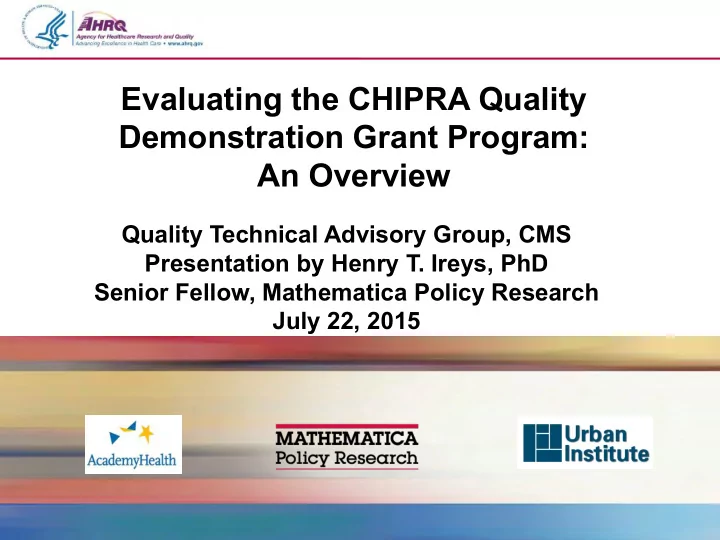

Evaluating the CHIPRA Quality Demonstration Grant Program: An Overview Quality Technical Advisory Group, CMS Presentation by Henry T. Ireys, PhD Senior Fellow, Mathematica Policy Research July 22, 2015
CHIPRA Quality Demonstration Program Quality Demonstration Program Congressionally mandated in 2009 CHIPRA $100 million dollar program – One of the largest federally-funded efforts to focus on child health care Five-year grants awarded by CMS – February 2010 - February 2015, with some extensions – About $10 million per grantee – 6 grants: Multi-state partnerships National evaluation – CMS funding, AHRQ oversight – August 2010 – September 2015 – Mathematica, Urban Institute, AcademyHealth 2
Demonstration grantees* and partnering states implemented 52 projects across 5 topic areast Category States Measures (10) HIT (12) Service Delivery (17) EHR Model Format (2) Other (11) Oregon* x x x Alaska x x x West Virginia x x x Maryland* x x Georgia x x Wyoming x x x Utah* x x x Idaho x x x Florida* x x x x Illinois x x x x Maine* x x x Vermont x x x Colorado* x x New Mexico x x Massachusetts* x x x South Carolina* x x x Pennsylvania* x x x North Carolina* x x x 3
Today’s presentation Highlight selected findings in three areas - Reporting core measure set to CMS - Using core measures for quality improvement (QI) initiatives - Improving service delivery Provide information about - What states did - What we learned Describe evaluation products and where to find them 4
Findings: Reporting core quality measures for children to CMS What States did - Hired dedicated programmers - Established State-level workgroups on quality of care measures - Worked across State agencies to link data - Fielded CAHPS more systematically - Developed standard testing procedures to ensure measure accuracy - Developed EPSDT profiles (State, network, practice levels) 5
Median Number of Child Core Set Measures Reported for FFY 2010 through FFY 2013 25 Number of Measures 20 15 10 5 0 FFY 2010 FFY 2011 FFY 2012 FFY 2013 Reporting Period Measure-Focused Demonstration States (n = 10) Other Demonstration States (n = 8) Non-Demonstration States and DC (n = 33) 6
Findings: Reporting core quality measures for children, continued What factors affect States’ ability to report core measures to CMS? - State’s history & culture around data collection - Challenges linking Medicaid/CHIP data to other sources (for example, immunization, survey, vital records) - Provider adoption of EHRs, EHR-to-State transmission capacity - Within-State demand for State-level reports 7
Findings: Using core quality measures for State-based QI initiatives What States did - Worked with State-level stakeholders (health plans, practice groups, child-serving agencies) to drive statewide QI efforts - Many States (for example, AK, FL, IL, MA, ME, NC, PA) used reports to 1) Compare performance of plans, agencies to national benchmarks 2) Identify variation in practices’ performance across regions, plans 3) Track changes in performance over time 8
Findings: Using core quality measures for State-based QI initiatives, cont’d Some of what we learned - Quality monitoring activities can provide powerful incentives for networks and health plans - Stipulating benchmarks in managed care contracts can be used to drive performance - Offering TA to practices can help them use State- generated quality reports - Collective effort essential for developing measure- based QI strategies 9
Findings: Service delivery models What States did - Worked with Child-serving practices & school-based health centers (SBHCs) to enhance patient centered medical home (PCMH) features Agencies serving youth with serious emotional disorders to enhance, develop care management entities (CMEs) - Offered varied combinations of interventions Learning collaboratives QI coaches, specialists TA assistance with data collection Incentives for participation, hiring practice-level staff 10
Preliminary findings on service delivery models, continued Some of what we learned - Learning collaboratives (LCs) Useful pathways for initiating practice transformation Critical to engage providers in defining LC topics - Hard to engage practices so incentives can be important Stipends Links to maintenance of certification (MOC) Web-based learning sessions QI materials customized to the practice Ongoing practice-level support - Practice-level supports are critical to expand impact of LCs State-supported practice facilitators: Need substantial QI training themselves 11
Other preliminary findings Electronic screening tools can support data quality, patient tracking and service monitoring Most demonstration States working on HIT projects faced major challenges - Interoperability between practices EHRs and State databases - Managing collaborations with multiple State agencies, vendors, other stakeholders - Legal barriers to data ownership and access State incentives for practice transformation don’t substitute for enduring payment models to support QI 12
Evaluation products Evaluation Highlights (13 issue briefs) Implementation Guides (2 how-to guides for States) Special postings on electronic screening for high-risk conditions (2 descriptions of these tools and their implications) Journal manuscripts (6 articles on research findings) 18 brief State summaries (description of what each state did and what they learned) Overall summary (brief description of major findings for Federal-level policy makers and program administrators) 13
For more information Dedicated CHIPRA Quality Demonstration Web page: The “go-to” place for information on the program and its evaluation – Descriptions of state projects – Evaluation Highlights, State summaries, and other documents – Reports from states – Links to CMS – Subscribe to receive updates www.ahrq.gov/chipra/demoeval/ 14
Recommend
More recommend